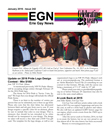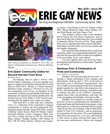HIV diagnoses decline almost 20 percent, but progress is uneven
Increases in some US populations but declines in others
December 6, 2015 - Annual HIV diagnoses in the United States fell by 19 percent from 2005 to 2014, driven by dramatic and continuing declines over the decade among several populations including heterosexuals, people who inject drugs, and African Americans – with the steepest declines among black women. However, the same level of success was not seen among all gay and bisexual men.
For gay and bisexual men, trends over the decade have varied by race and ethnicity. Among white gay and bisexual men, diagnoses dropped steadily, decreasing 18 percent. Diagnoses among Latino gay and bisexual men continued to rise and were up 24 percent. Diagnoses among black gay and bisexual men also increased (22 percent) between 2005 and 2014, but that increase has leveled off since 2010.
A similar trend was seen among young black gay and bisexual men ages 13-24, who experienced a steep 87 percent increase in diagnoses between 2005 and 2014. Between 2010 and 2014, however, the trend has leveled off (with a 2 percent decline).
"Although we are encouraged by the recent slowing of the epidemic among black gay and bisexual men – especially young men – they continue to face a disproportionately high HIV burden and we must address it," said Jonathan Mermin, M.D., director of CDC's National Center for HIV/AIDS, Viral Hepatitis, STD, and TB Prevention. "Much more must be done to reduce new infections and to reverse the increases among Latino men. There is hope that the National HIV/AIDS Strategy and other efforts are beginning to pay off, but we can't rest until we see equal gains for all races and risk groups."
The new national analyses examined trends in diagnoses over two time periods, 2005-2014 and 2010-2014, to provide both a decade-long perspective as well as a more recent view of trends. Among the findings:
- From 2005-2014, the annual number of HIV diagnoses in the U.S. declined 19 percent (from 48,795 to 39,718 per year) – driven by substantial declines among heterosexuals (down 35 percent) and people who inject drugs (down 63 percent).
- HIV diagnoses among black women were cut nearly in half, from 8,020 to 4,623 over the 2005-2014 period (42 percent decline), with continuing declines in recent years (25 percent since 2010).
- Diagnoses among gay and bisexual men overall increased about 6 percent over the decade (from 25,155 to 26,612), but stabilized in more recent years (a less than 1 percent increase from 26,386 to 26,612).
- Among white gay and bisexual men, diagnoses dropped steadily – both over the decade (decreasing 18 percent from 9,966 to 8,207) and in more recent years (decreasing 6 percent from 8,766 to 8,207).
- Over the decade, diagnoses among black gay and bisexual men increased by 22 percent (from 8,235 to 10,080) but stabilized in more recent years (a less than 1 percent increase, from 10,013 to 10,080).
- Further, while black gay and bisexual men ages 13-24 experienced a steep increase (87 percent from 2,094 to 3,923) in diagnoses over the decade, diagnoses among young black gay and bisexual men actually declined by 2 percent (from 3,994 to 3,923) in the most recent years.
- Finally, diagnoses continued to increase among Latino gay and bisexual men – both over the decade (by 24 percent from 5,492 to 6,829) and in more recent years (by 13 percent from 6,060 to 6,829).
HIV testing remained stable or increased among the groups experiencing declines in diagnoses in recent years. Researchers therefore believe the decreases in diagnoses reflect a decline in new infections. Similarly, because HIV testing remained stable among Latino gay and bisexual men during this period, the increases in HIV diagnoses suggest infections are likely increasing in this group.
"The recent five-year trends coincide with the launch of the first National HIV/AIDS Strategy and – now that the investment in high-impact prevention approaches has increased – offer promise for further progress," said Eugene McCray, M.D., director of CDC's Division of HIV/AIDS Prevention. "We have the tools to stop HIV right now. We urgently need to accelerate access to testing, treatment, and new biomedical prevention strategies so that everyone can protect themselves and their partners."
Dr. McCray today announced the analysis of HIV diagnosis trends during his plenary speech launching the National HIV Prevention Conference. The 2015 National HIV Prevention Conference, convened by the CDC and many public, private, and government agencies, will take place in Atlanta, Dec. 6-9. This meeting focuses on the full spectrum of HIV prevention, giving community organizations, public health professionals, clinicians, advocates, and other interested individuals the opportunity to exchange information about effective prevention approaches. For more information about the conference, please visit www.cdc.gov/nhpc.
CDC works 24/7 protecting America's health, safety and security. Whether diseases start at home or abroad, are curable or preventable, chronic or acute, stem from human error or deliberate attack, CDC is committed to respond to America's most pressing health challenges.



